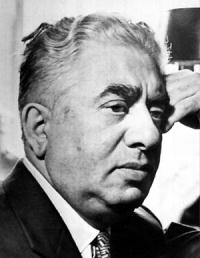Aram Khachaturian Biography - A Very Quick Guide
Aram Ilich Khachaturian (Armenian: Արամ Խաչատրյան, Russian: Аpaм Ильич Xaчaтypян) (June 6, 1903 – May 1, 1978) was a composer of classical music.
Khachaturian was born in Tiflis, Georgia, Russia (now Tbilisi, Georgia) to a poor Armenian family (the influence of Armenian folk music is prominent in his work). In his youth, he was fascinated by the music he heard around him, but at first he did not study music or learn to read it. In 1921, he travelled to Moscow all on his own in order to begin his musical studies, having almost no musical education and unable to speak a word of Russian. However, he showed such a great musical talent that he was admitted to the Gnesin Institute where he studied cello under Mikhail Gnesin and entered a composition class (1925). In 1929, he transferred to the Moscow Conservatory where he studied under Nikolai Myaskovsky. In the 1930's he married the composer Nina Makarova, a fellow student from Myaskovsky's class. In 1951, he became professor at the Gnesiny State Musical and Pedagogical Institute (Moscow) and the Moscow Conservatory.
His works include concertos for violin, cello and piano (the latter originally including an early part for the flexatone), concerto-rhapsodies for the same instruments, three symphonies the third containing parts for fifteen trumpets and organ, and the ballets Spartak (Spartacus) and Gayane, the latter featuring in its final act what is probably his most famous movement, the 'Sabre Dance'. He also composed some film music. The cinematic quality of his music for Spartacus was clearly seen when it was used as the theme for a popular BBC drama series, The Onedin Line, during the 1970s. Since then, it has become one of the most popular of all classical pieces for UK audiences.
He died in Moscow, short of his 75th birthday.
External links
- NPR report including many audio examples of his Sabre Dance (http://www.npr.org/display_pages/features/feature_1287262.html)
- Aram Khachaturian 100th anniversary Web site (http://www.armeniadiaspora.com/events/aram100/index.html)
- Music composed by Khachaturian (http://home.wanadoo.nl/ovar/kachcata.htm)

